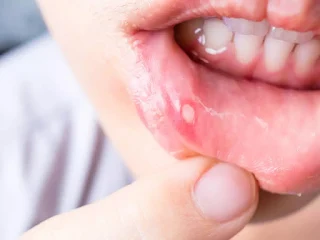Mouth Ulcers
Introduction
Mouth ulcers has 3 main clinical presentations.
- Minor aphthous ulcers (MAUs)
- Most cases of mouth ulcers (80%) are minor aphthous ulcers, which are self-limiting (last from 5 to 14 days).
- The cause is unknown.
- The lesions (usually 5-6 mm in diameter) appear as a white or yellowish centre with an inflamed red outer edge.
- Pain is the key presenting symptom and can make eating and drinking difficult, although pain subsides after 3 or 4 days.
- Major aphthous ulcers
- Characterized by large (>1 cm in diameter) numerous ulcers, occurring in crops of 10 or more.
- Sites involved are the lips, cheeks, tongue, pharynx and palate.
- Takes 10-30 days to heal.
- Herpetiform ulcers
- Are pinpoint, often occur in large crops of up to 100 at a time, and can be extremely painful.
- Fresh crops of herpetiform ulcers tend to appear before the original crop has healed, which may lead patients to think that the ulceration is continuous.
Causative Factors
Ill-fitting dentures may produce ulceration.
- If this is a suspected cause, the patient should be referred back to dentist so that the dentures can be refitted.
Certain "trigger food" may contribute to the recurrence of aphthous ulcers, such as chocolate, spicy foods, coffee, peanuts, almonds, strawberries, cheese, tomatoes and wheat flour.
The oral mucosa is particularly vulnerable to ulceration in patients treated with cytotoxic drugs, e.g. methotrexate.
- Other drugs capable of causing oral ulceration include ACE inhibitors, gold, nicorandil, NSAIDs, pancreatin, penicillamine, proguanil hydrochloride and protease inhibitors.
In women, minor aphthous ulcers often precede the start of the menstrual period.
- The occurrence of ulcers may cease after pregnancy, suggesting hormonal involvement.
Deficiency of iron, folate, zinc or vitamin B12 may be a contributory factor in aphthous ulcers and may also lead to glossitis and angular stomatitis.
Other Important Considerations
Any mouth ulcers that have persisted for longer than 3 weeks requires immediate referral to the dentist or doctor.
- An ulcer of such long duration may indicate serious pathology, such as carcinoma.
Mouth ulcers may be associated with inflammatory bowel disease (such as ulcerative colitis or Crohn's disease) or coeliac disease.
- Therefore, if persistent or recurrent diarrhoea is present, referral is essential.
In children under 10 years, hand, foot and mouth disease should be ruled out.
- Hand, foot and mouth disease patients usually present with a maculopapular/vesicular rash on the extremities (predominantly the hands and to a lesser extent the feet) and painful oral lesions, which is often preceded by a 12-36 hour prodrome that may include fever. The rash may also involve the knees, elbows, buttocks and/or genital areas.
- It is highly contagious, and good hygiene is required to prevent it from spreading to others.
OTC Medications for Minor Aphthous Ulcers
A wide range of products are used for the temporary relief and treatment of mouth ulcers.
- Topical corticosteroids (e.g. dexamethasone, triamcinolone acetonide)
- Acts locally to reduce inflammation and pain, and is thought to shorten healing time (although evidence is weak).
- Local analgesics or anaesthetics (e.g. benzydamine mouthwash, choline salicylate dental gel and lidocaine)
- Producing temporary pain relief.
- In 2009, the CHM has advised that topical oral pain relief products containing salicylate salts should not be used in children under 16 years, as a cautionary measure due to the theoretical risk of Reye's syndrome.
- Topical hyaluronic acid (e.g. Aloclair, Aftamed and Gengigel)
- It coats the oral mucosa, enhances tissue hydration and accelerates healing.
- The manufacturers advise not eating or drinking for 1 hour after application.
- Antibacterials (e.g. chlorhexidine mouthwash)
- There is some evidence that chlorhexidine mouthwash reduces duration and severity of ulceration.
- The rationale is chlorhexidine helps to prevent secondary bacterial infection, which can increase discomfort and delay healing.
- The mouthwash should be used twice a day, rinsing 10 ml in the mouth for 1 minute, and continue for 48 hours after symptoms have gone away.
- Side effects associated with chlorhexidine mouthwash use include reversible tongue and tooth discolouration, burning of the tongue and taste disturbances.
Gels and liquids may be more accurately applied with the help of a cotton bud or cotton wool, provided the ulcer is readily accessible.
- Mouthwashes can be useful in cases where ulcers are difficult to reach.
Summary
Minor aphthous ulcers are typically self-limiting, meaning they will heal spontaneously even without treatment.
- Topical corticosteroids or anaesthetics are used to provide pain relief, enabling patients to eat more comfortably.
External Links
- Use of steroids in treatment of aphthous ulceration, 1968
- Hexetidine mouth rinse in the management of minor aphthous ulceration and as an adjunct to oral hygiene, 1991
- Oral salicylate gels: not for use in those younger than age 16 years, 2014
- Systematic review: the efficacy of topical hyaluronic acid on oral ulcers, 2017

Comments
Post a Comment